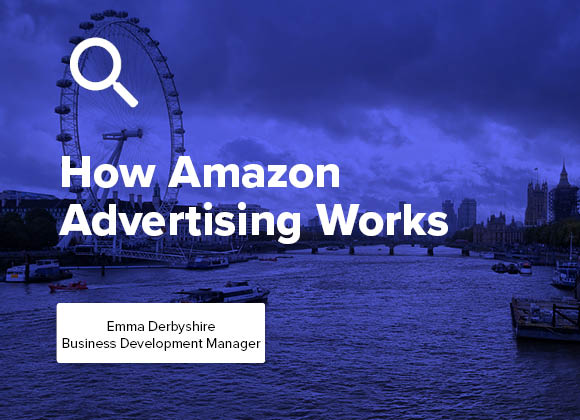Raise your hand if you have heard of Amazon. Kidding, of course. Everyone has heard of Amazon. In fact, Amazon has a 45% share of the entire US eCommerce market. We’ll give you a minute to let that one sink in. This makes Amazon the biggest eCom giant in the market currently and it is growing rapidly with an increase of approximately 3,700 new sellers every single day.
So, when we talk about the opportunity to advertise on Amazon, we are talking big time. With great buyer behaviour data and a huge reach, what more convincing could retailers need? One of our favourite things about Amazon though, is the loyalty of its users. Research demonstrates that due to the vast amount of products available and because of other perks like cheap next day delivery via their Prime service, that Amazon shoppers very rarely consider shopping elsewhere.
So of course, with being able to boast the above statistics and USPs, amongst many others, Amazon has built a huge advertising business! They enable brands to not only advertise on Amazon but also amongst their third party network with both Product and Video Ads. Let’s delve a little deeper to what the advertising platform has to offer….
Sponsored Product Ads
Sponsored Product Ads work on a PPC framework, the same as Google Ads. They offer advertisers the opportunity to promote certain products using keyword targeting. They can set a max bid for any term and naturally the highest bid is most likely to be displayed. Payment works the same as Google’s Ads, retailers only pay for clicks.
Sponsored Product Ads can be seen within the Amazon search results page or above or next to them. Sometimes, they even appear within product detail pages.
According to Amazon themselves, this is the easiest place for retailers with little Ad campaign experience to start on the platform.
What is especially impressive about the opportunity for retailers using Sponsored Product Ads, is that Amazon’s data will allow them to exclude customers that have recently purchased the product advertised (or something very similar) from audiences. Therefore, they are not wasting Ad spend on users that are not ready to re-purchase yet and won’t be in the market again for a little while. Clever right?
Sponsored Brand Ads
Sponsored Brand Ads appear in Amazon listings when a generic product search term is made.
In the example you can see above, the user has searched for the generic term, ‘2023 diaries.’ You can see at the top of the listing that Collins is running a sponsored Brand Ad. These always feature in the top section of the results page and feature the brand’s logo, a small blurb and a few relevant products. This is the perfect opportunity for brands to target non-brand loyal buyers looking for their products. It’s great for brand awareness and new customer acquisition.
In the same way with the Sponsored Product Ads, these brand Ads work on a PPC basis.
A huge advantage of brand Ads is that they are much more subtle than other types of shopping Ads. To the trained eye, they don’t really look like Ads at all, having a more organic impression on the consumer.
On the point of advert subtlety, a study of 2000 Amazon users revealed that over 50% of them don’t realise that they are being advertised to on the platform.
Amazon Display Ads / Amazon DSP (Demand Side Platform)
This type of Amazon advertising allows sellers to programmatically buy Display and Video Ads at scale. These appear not just on the Amazon site or app itself, but also on other Amazon owned platforms such as on Kindle or Fire TV sticks, as well as third party network sites.
One of the great things about Amazon DSP is that it opens the platform up to businesses that sell services opposed to products. For example, using Amazon’s incredible customer purchase data a mechanic would be able to advertise their business to Amazon customers that have recently been purchasing items that suggest they may need some work doing on their car. Or, an audience that has been purchasing a lot of home related products, would be the perfect audience for a home insurance brand or perhaps a decorator.
This type of Ad really blows the opportunity for Amazon wide open when it comes to working with not just retailers but also businesses that sell services too, B2B and B2C. It enables them to use the goldmine of data that Amazon has to offer on customer behaviour and purchase history to grow their business in terms of leads but also brand awareness.
So there you have it, a whistle stop tour of how Amazon Advertising Works, the types of Ads you can run and the data you can leverage whilst doing so. Would this be a blog post without providing you with a bullet point list of advantages of using the platform though? We don’t think so, so here you go:
- Qualified audience in a safe band environment
- Accurate sales history and product visibility reporting
- Brand awareness
- Insights into ever changing consumer habits and purchase behaviour
- Easily trackable results
- Variety of Ads available
You are welcome!
To summarise, Amazon’s advertising business is growing rapidly. It is important in 2023 that retailers are being proactive in considering and using this platform in a strategic and flexible way in order to stand out.
Here at eComOne we have enjoyed learning about Amazon’s constantly iterative advertising platform over the past couple of years and would love to have a chat with you about how you could scale your business this year using its incredibly unique customer data and insights.


